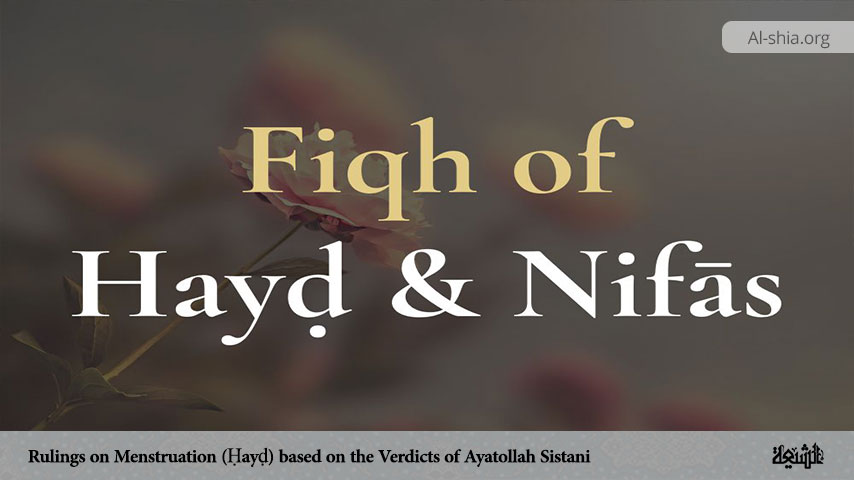Rulings on menstruation [ḥayḍ in Arabic] is one of the Islamic rulings that are peculiar to the womenfolk. It is therefore obligatory for the women to know and understand properly the related rulings, in order to avoid falling into sins or leading to abnormality in their worship.
In view of this, the following rulings are based on the religious verdicts (Fatawa) of the top Shia religious authority (Marja); Ayatollah Sayyed Ali Husseini Al-Sistani (may Allah prolong his authority) as discussed in his treatise titled “The Islamic laws”. For simplicity and a better understanding of the content, the rulings are rearranged and placed under different sub-headings:
What is Menstruation [Ḥayḍ]?
Ḥayḍ is the blood that is usually discharged from the uterus of women every month for a few days. A woman in menstruation is called a ‘ḥāʾiḍ’.
The Attributes of Menstruation [Ḥayḍ]
Most of the time, the blood of ḥayḍ is thick and warm, its colour is black or red, and it comes out with a little pressure and a burning sensation.
Age for Menstruation [Ḥayḍ]
1. The bleeding that women above the age of sixty experience is not ruled to be ḥayḍ. However, a woman can experience ḥayḍ between the age of fifty and sixty, although the recommended precaution is that women who are not Qurayshi (sayyidah)[1] and who experience bleeding which would previously have been ruled to be ḥayḍ [i.e. had they experienced it before the age of fifty, it would have been ruled to be ḥayḍ], should refrain from doing the things that are unlawful for a ḥāʾiḍ to do and perform the duties of a mustaḥāḍah.
2. If a woman who doubts whether she has reached the age of sixty experiences bleeding but does not know if it is ḥayḍ, she must assume that she has not reached the age of sixty.
3. Bleeding that a girl experiences before the age of nine is not ḥayḍ. If a girl who does not know whether she has completed nine years of age experiences bleeding that does not have the attributes of ḥayḍ, it is not ḥayḍ. If it has the attributes of ḥayḍ, then considering it to be ḥayḍ is problematic [i.e. based on obligatory precaution, it must not be considered to be ḥayḍ], unless one is confident that it is ḥayḍ, in which case the girl will be considered to have reached the age of nine.
NOTE:
It is possible for a pregnant woman and a breastfeeding woman to menstruate. The ruling of a pregnant woman and a non-pregnant woman is the same except that if a pregnant woman who has a habit of time experiences bleeding with the attributes of ḥayḍ after the passing of twenty days from the first day of her habit, it is necessary for her, based on obligatory precaution, to do the things that a mustaḥāḍah must do and refrain from doing the things that are unlawful for a ḥāʾiḍ to do.
Period of Menstruation [Ḥayḍ] and its Rulings
1. Ḥayḍ cannot last for less than three days or more than ten days; if bleeding lasts for even a little less than three days, it is not ḥayḍ.
2. The first three days of ḥayḍ must be continuous; therefore, if, for example, a woman experiences bleeding for two days, and then the bleeding stops for one day, and then she experiences bleeding again for one day, it is not ḥayḍ.
3. At the beginning of ḥayḍ, it is necessary for the blood to come out. However, it is not necessary for the blood to come out on all three days, and it is sufficient if the blood remains inside the vagina. In the event that during the three days a woman’s bleeding stops for a short time in a manner that is common among all or some women, it is still counted as ḥayḍ.
4. It is not necessary for a woman to experience bleeding on the eve of the first and fourth day. However, the bleeding must not stop on the eve of the second and third day. Therefore, if from the start of the morning of the first day, the bleeding continues until sunset of the third day and does not stop at all, it is ḥayḍ. The same applies if it starts on the first day and stops at the same time on the fourth day.
5. If a woman experiences bleeding for three consecutive days and then her bleeding stops, in the event that she experiences bleeding again and the days on which she experiences bleeding plus the days on which her bleeding stops in between altogether do not exceed ten, then the blood on all the days that she experienced bleeding is ḥayḍ. However, the obligatory precaution is that on the days that her bleeding stops in between, she must do the things that are obligatory for a non-ḥāʾiḍ and refrain from doing the things that are unlawful for a ḥāʾiḍ.
6. If a woman experiences bleeding for more than three and less than ten days, but she does not know whether the bleeding is from a boil, wound, or due to ḥayḍ, she must not consider it to be ḥayḍ.
7. If a woman experiences bleeding but does not know whether it is from a wound or due to ḥayḍ, she must perform her ritual acts of worship (ʿibādāt) [as normal], unless prior to this she was in the state of ḥayḍ [in which case she would consider it to be ḥayḍ].
Miscellaneous Rulings on Ḥayḍ [Menstruation]
1. If a woman experiences bleeding and doubts whether it is ḥayḍ or istiḥāḍah, in the event that it has the conditions of ḥayḍ, it must be considered to be ḥayḍ.
2. If a woman experiences bleeding and does not know whether it is ḥayḍ or bleeding caused by her hymen tearing, she must examine herself; i.e. she must insert some cotton in the vagina, wait a while, and then take it out. If she finds that blood has stained only the sides of the cotton, it is bleeding caused by her hymen tearing, but if it has reached all parts of the cotton, it is ḥayḍ.
3. If a woman experiences bleeding for less than three days, and then her bleeding stops, and afterwards, she experiences bleeding again for three days, the second bleeding is ḥayḍ and the first bleeding – even if she experiences it during her habitual period – is not ḥayḍ.
Footnote
[1] . A sayyidah is a female descendant of Hāshim, the great grandfather of Prophet Muḥammad (PBUHH).


















